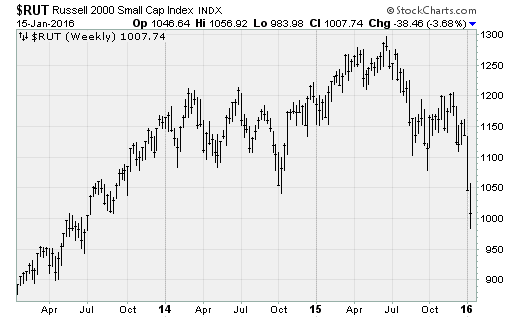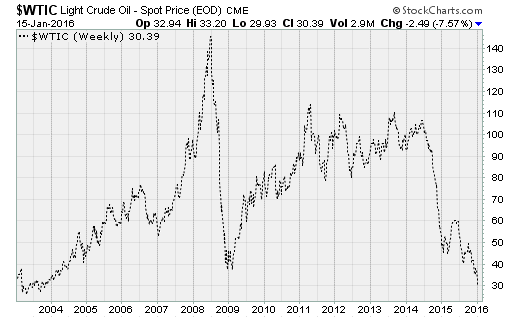Is this the end of the bull market?
Stocks were hit hard on on Friday, with the Dow Jones industrials index losing more than 500 points at the day's low before closing 391 point lower and below the 16,000 level. Things are even worse for small-cap stocks, with the Russell 2000 down than 22 percent from its highs last summer (chart below) -- the technical definition of a new bear market.
The pain is mind-numbing. This is the worst start to the year for stocks ever, with the S&P 500 losing $1.4 trillion so far, while the Dow is down $547 billion, according to Howard Silverblatt, senior index analyst at Standard & Poor's. Only 40 of the stocks in the S&P 500 are in positive territory for 2016.
Many factors are in play: The ever-worsening collapse in crude oil, volatility in China, weak economic data at home and overseas, tepid earnings, the threat of additional Federal Reserve rate hikes and bond market vulnerabilities.
Whether the losses deepen or an oversold rebound materializes depends mainly on two things: Crude oil prices stabilizing (despite the lifting of Iranian oil sanctions) and the Fed delaying further rate hikes (until market confidence has been restored).
The economic data certainly supports a dovish turn by the Fed. Headline retail sales dropped 0.1 percent, with 2015's performance by consumers the weakest since 2009. Industrial production fell a larger-than-expected 0.4 percent in December. U.S. freight volumes are falling for the first time in three years. Wal-Mart (WMT) is firing 16,000 workers and closing 269 stores globally.
The Atlanta Fed's GDPNow estimate for fourth-quarter GDP growth has dropped to just 0.6 percent.
Long story short: A deflation dynamic -- led by weak oil prices (chart above) -- is ripping through an overindebted, overleveraged and overoptimistic financial system. It's fueled by a mix of Fed policy tightening (QE3 bond buying ended in December 2014 and rates were hiked 0.25 percent in December 2015 for the first time since 2006) and a U.S.-OPEC oil price war.
Other wrinkles include the situation in China (currency instability and capital outflows), weak corporate earnings (on track for a third straight quarterly decline in fourth-quarter 2015) and the fact that cheaper oil prices have done more to hurt (by cutting capital investment) than help (by boosting consumer spending).
The kicker: If the Fed can engineer a reversal of the cheap oil/strong dollar dynamic by holding off on rate hikes or even considering new stimulus measures, the market could quickly rebound.
But that would be at the risk of lost credibility by Fed Chair Janet Yellen, reinforcement of the idea of the "Fed put," encouragement of excessive risk-taking by complacent investors and the not insignificant risk of runaway inflation down the road.
We may have already seen a hint of this: Earlier on Friday, New York Fed President William Dudley said negative interest rates would be considered if the economy weakened. As recently as September, now retired Minneapolis Fed President Narayana Kocherlakota was suggesting negative interest rates were appropriate in 2016.
Merely a pause in the Fed's rate hike pace could be enough. As a reminder: In December the Fed maintained a forecast of four quarter-point hikes for 2016. While this is much slower than its typical policy tightening, the pace it is about twice as fast as the futures market was expecting. Now, investors aren't looking for the Fed to move again on rates until September according to Oxford Economics.
Lacking support from the Fed, large-cap stocks could soon join small-caps in a new bear market. The bulls have two weeks to turn it around: Silverblatt noted that should the stock market finish January in the red, there's a 72.4 percent chance it will finish 2016 in the red, too.


